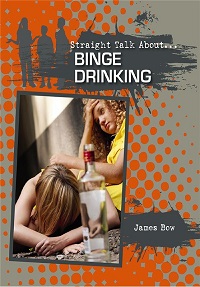| ________________
CM . . .
. Volume XXII Number . . . .September 25, 2015
excerpt:
Four years ago, I had the opportunity to review six titles in a then-new series launched by Crabtree Publishing, the “Straight Talk About . . .” series. Since then, four new titles have been added to the series: Straight Talk About . . . Binge Drinking, . . . Digital Dangers, . . . Sexual Orientation and Gender Identity, and . . . Dealing with Loss. As with the earlier books in the series, the four titles maintain a common format. Each is exactly 48 pages long (available in either library binding or paperback), and is illustrated with full-colour photos, as well as quotes from young people who have experienced the focus issue. The books all begin with a vignette - an incident depicting an authentic experience with the problem under exploration. The excerpt above, taken from Straight Talk about Binge Drinking, offers a snapshot of two young women at a party who have definitely drunk too much, one has passed out, and a crisis is in the works. Following each one-page vignette is a brief “Introduction” to the book’s topic, and subsequent chapters explore its various dimensions (i.e. Drinking and the Law, Binge Drinking and Bad Decisions, Binge Drinking and Your Health). The final chapters of each book offer advice on ways to handle the problem in a positive, non-judgmental fashion, along with suggestions on how to seek help for oneself or give assistance to friends; a two-page section entitled “Hot Topics Q & A”; a two-page listing of “Other Resources” (providing the telephone numbers of help-lines and reliable web sites hosted by support organizations in both Canada and the U. S.), and a final page that combines both a Glossary and a brief Index. Straight Talk about Binge Drinking begins with some rather frightening statistics about alcohol abuse amongst American high school students: the ready availability of alcoholic products in stores, portrayal of its use in movies and television, and constant advertising in all manner of media heightens adolescent curiosity “about what it’s like to drink.” (p. 11) That curiosity can easily lead to over-consumption, especially because “binge drinkers want to get drunk fast” (p. 13). But, binge drinking impairs the drinker physically (reflexes and reaction time are delayed), emotionally (although alcohol is a depressant, some people become aggressive and hostile), and lowers levels of judgement and inhibition. That lack of inhibition can lead to some very serious consequences: young female drinkers are vulnerable to sexual assault, unplanned pregnancy, or date-rape, while guys can find themselves involved in serious accidents, the kind where the police report that “alcohol was a factor”. An interesting feature of the book is a two-page exploration of common myths and real facts about binge drinking: for the record, “vomiting does not help you sober up.” (p. 29) Of course, binge drinking has serious impact on a person’s health. “Alcohol’s effect on the brain is especially troublesome for kids and teens whose brains are still developing.” (p. 33) While alcohol poisoning may lead to a hospital visit, it can just as easily lead to death, and continued binge drinking has the potential to damage the body and brain, both in the present, and in later life. It’s clear that binge drinking is a serious problem, but whether a teen, his or her friend, or family member has a problem, this book supplies strategies for saying “no”, for taking control of the problem, and for finding the help and support needed in order to stop. While alcohol abuse may be an old problem, Straight Talk about Digital Dangers explores a very new one. On the book’s cover, a young women stares at her phone, surprised and shocked at the content of the message or photo. Internet, e-mail, social media, instant messaging apps and text messaging have made communication instant. Unfortunately, the same cyber-tools which make it possible to stay in near-constant communication with friends also leave teen users open to bullying and harassment by those who can easily remain anonymous or hide under the cover of a false on-line identity. Cyber bullying is malicious and, in some well-known cases (Amanda Todd, Rehteah Parsons), has led to the tragedy of teen suicide. Adults – many of whom grew up at a time when the biggest danger was the stranger to whom one was not supposed to talk– can be oblivious to what happens in the online lives of their kids or students and don’t realize just how serious the problem is until their son or daughter is experiencing serious emotional problems as a result of cyber bullying. Other adults, however, deliberately exploit the potentials of on-line contact, seeking out kids who are vulnerable or lonely. Digital predators “are on the lookout for anyone going through a tough time” (p. 14); some predators are pedophiles, some are looking for financial gain (phishes), while others (catfish) create fake identities in order to get attention and sympathy. Much of the content of Straight Talk about Digital Dangers provides both teen and adult readers with a much-needed lesson in cyber-literacy. While it seems as if everyone has a Facebook page these days, not every Facebook user has an understanding of the limitations of privacy settings. Twitter also offers potential for one’s posts (photos, videos, messages) to go viral; not enough people think before they Tweet. Given that some “surveys show that 50 per cent of teenagers log into a social media site every day” (p. 23), there’s huge opportunity for private information to be made very public. As for “sexting” - the sending of sexually explicit messages, images or other content - that is an incredibly risky activity, and, if the images are of under-age children, they can be considered child pornography. Many teens access on-line content for research purposes. As any teacher-librarian can tell them (not that they’ll listen), just because information is on-line doesn’t mean it’s accurate. “Even reputable sites can get it wrong” (p. 31), and that includes Wikipedia. On the other side of the digital world is entertainment, and video games are a typical diversion. Harmless fun? Perhaps, but digital games have come a long way from the Pong and Pac-Man of my younger days. Some games “include lifelike violence and negative images of women”, (p. 39) and others contain adult content that is clearly unsuitable for younger players. Gamers can get quite caught up in cyber-play and become addicted to the screen and controller, forgetting that there’s a real world out there. Some get so involved in the competition of the game that “trash talk” turns into cyber bullying. There’s plenty to be wary of in the cyber-world, and the final pages of Digital Dangers provides some helpful reminders of ways to stay cyber-safe and protect one’s devices and one’s privacy. One’s sexual orientation and gender identity used to be a private matter. But with high-profile stories, such as the gender identity change of Caitlin (formerly Bruce) Jenner, it has become very public. Straight Talk about Sexual Orientation and Gender Identity explores the very complex issue of gender, the roles which cultures assign to the two genders, and what happens to those who somehow just don’t fit culturally defined assumptions. Rather surprisingly, “about one in 2,000 babies are born without a clearly defined sex.” (p. 8) However, it seems that “sex is a biological fact and gender is how you feel inside.” (p. 11) The cultural dimensions of gender are strong, but there is also a biological component. While biology may determine an individual’s sex, and gender identity is what an individual believes him or herself to be, sexuality, or sexual orientation, is all about romantic attraction, whether to men, women, both, or neither. (p. 19) Those who identify themselves as LGBTQ (lesbian, gay, bisexual, transgendered and questioning) are often the victims of hatred and violence. While the LGBTQ rights movement gained strength during the 1960s, along with other human rights causes, it is clear that, for many LGBTQ teens, “coming out” (i.e. declaring one’s sexual identity) can still be a difficult and frightening process. Family, friends, team members, or one’s religious community may not be supportive, and, for that reason, some teens remain “closeted” until they are older and feel comfortable doing so. This book also explores the history of such social changes as same-sex marriage and the many changes in family structures that have resulted from gay parents choosing to have children, and straight parents accepting their gay children and partners. Clearly, it’s not always easy for LGBTQ teens; many face insults, bullying, alienation from their families, (often leading to homelessness and the perils of life on the streets), and, in the worst cases, they choose suicide as an end to the pain. But, there is support, and this book offers a number of ways in which LGBTQ teens can connect with those who can help them to find that, over time, after “facing tough times . . . life gets better.” (p. 43) For those who are grieving, it can seem impossible to believe that life will get better. Straight Talk about Dealing with Loss explores the experience of loss and grief. It is normal to feel sad. A person may feel sad about the death of a parent, a close relative, a pet or a friend. But grief is more than just sadness at the absence of someone or something very dear to you. It is a bundle of difficult emotions and, on a physical level, very tiring. Of course, there are life losses other than death: a relationship or close friendship can end, students might change schools, move to another place, or a family can suddenly find itself in terrible difficulty due to job loss or a serious health crisis. But, for many teens, it’s loss through death that is the typical cause of deep grief, and, whether sudden or unexpected, it can be overwhelming. The five stages of grief, popularized by the work of Elizabeth Kubler-Ross are enumerated, but this book notes that the process of grieving is not necessarily linear; they are“not a road map, but a general path.” (p. 11) Any adult who has experienced a serious loss knows that grief is not just an emotional state; physical responses, such as changes in appetite, sleep patterns, mental focus, and energy level, are all typical. For a teen, however, the physical dimensions are often unexpected. Teens and kids typically have less experience of grief than older people. Add to this the emotional intensity of adolescence, and a profound loss has the potential for some real behavioral changes. Some teens choose to self-medicate through drugs and alcohol, some engage in “self-destructive behavior, such as self-cutting or thoughts of suicide” (p. 31), some withdraw from activities which have been important, and some sink into a state of deep depression. Interestingly, this book explores the whole issue of whether or not crying is okay. Some teens refrain from crying because it “can make some people uncomfortable”, (p. 23) even though tears might be a relief. This book makes it clear that both crying, or not crying , are acceptable responses and suggest ways of making both situations manageable. Although grief-stricken teens hope that family and friends can support them, sometimes they can’t. In the case of other family members, perhaps they are dealing with their own grief and have no personal resources left to support another. In the case of friends, perhaps it’s because of their own discomfort with their friend’s emotional state, or because they can’t figure out what to do or say. One of the most important chapters in this book offers ways of dealing with a friend’s grief: don’t try to fix it, just be there for them (p. 34). And if, when spending time with a friend, there are signs of trouble, the best thing that a friend can do is to heed the signs and get help for their friend: “it’s better to be safe than sorry.” (p. 36) The final chapter reminds the reader that “grief is manageable” (p. 39), but, in order to manage it, you must acknowledge it, and realize when you can’t deal with it on your own. The four new titles in the “Straight Talk About . . .” series do an excellent job of exploring some very difficult life issues. The font size of the text is large, and the publicity sheet for the series states that the reading level is Grade 5, suggesting that the intended audience might be middle school rather than high school, but the photos illustrating the books are definitely those of older students. I think, as well, that these books deal with issues which might resonate more with high school students than with upper middle school students, even though some of the pull quotes are from 13-year-olds. However, for high school students looking for a quick and accessible overview of these topics, these titles fill the bill. All four titles are definitely a worthwhile addition to senior high school library collections. I think that guidance and counseling staff will find the books especially helpful resources for their client. Despite the fact that the books offer “self-help”, I am uncertain that students struggling with these issues will be likely to seek them out in a library collection for that purpose, although they are likely to use them as the starting point for a fact-based report on the subjects. Highly Recommended.
Joanne Peters, a retired teacher-librarian, lives in Winnipeg, MB.
To comment on this title or this review, send mail to cm@umanitoba.ca.
Copyright © the Manitoba Library Association. Reproduction for personal use is permitted only if this copyright notice is maintained. Any
other reproduction is prohibited without permission.
CM Home |
Next Review |
(Table of Contents for This Issue - September 25, 2015.)
| Back Issues | Search | CM Archive
| Profiles Archive |



